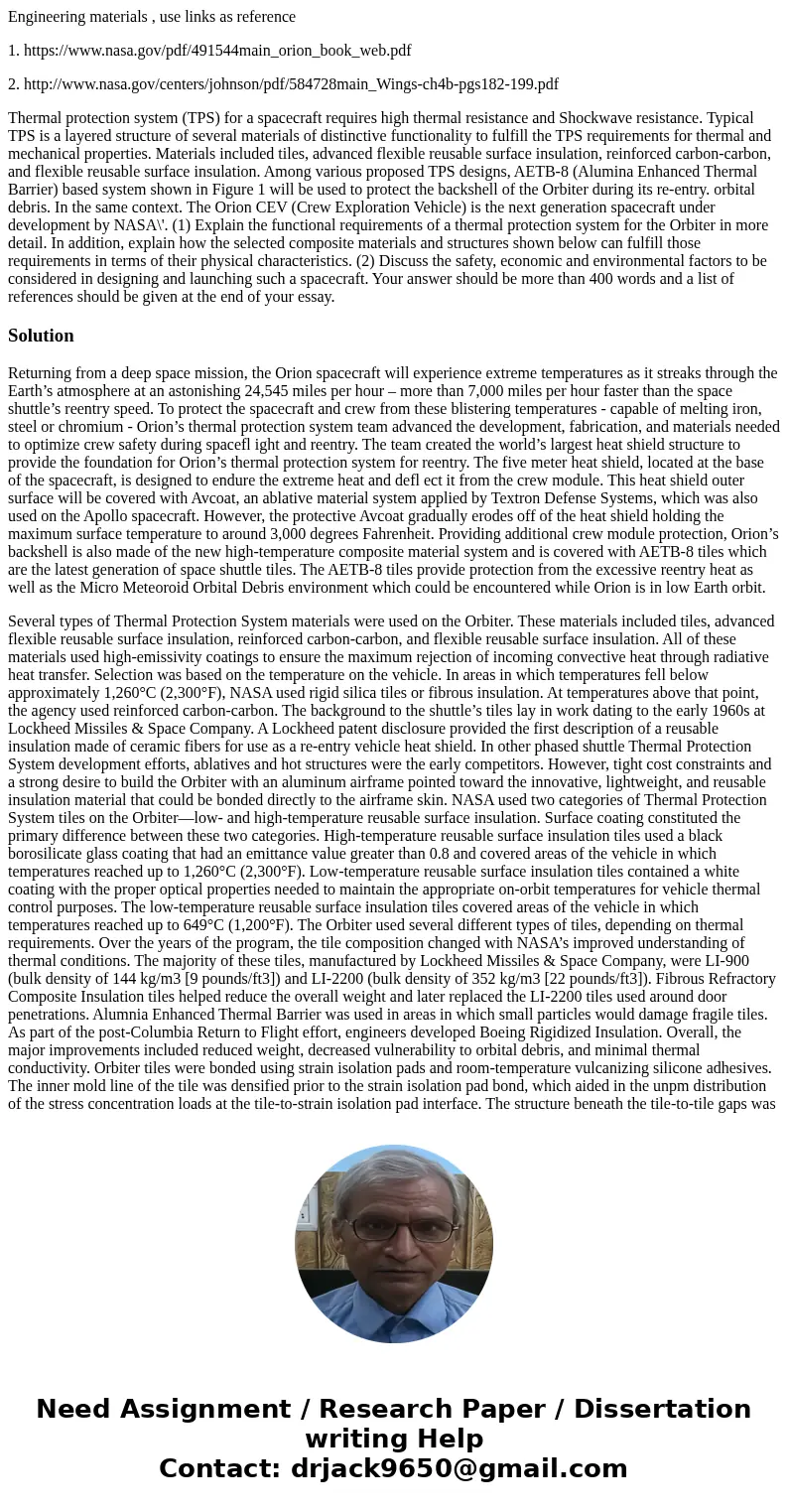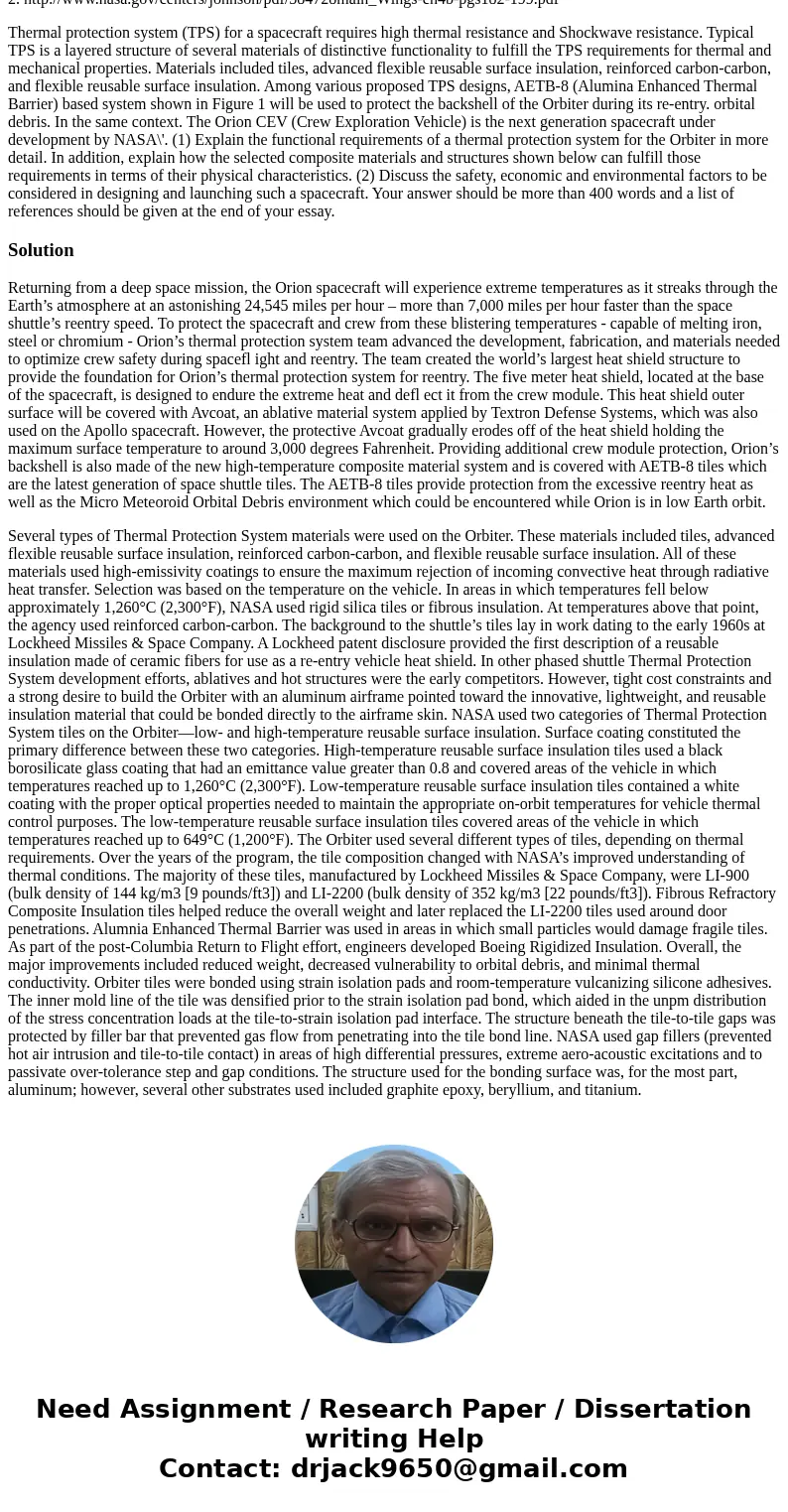Engineering materials use links as reference 1 httpswwwnasa
Engineering materials , use links as reference
1. https://www.nasa.gov/pdf/491544main_orion_book_web.pdf
2. http://www.nasa.gov/centers/johnson/pdf/584728main_Wings-ch4b-pgs182-199.pdf
Thermal protection system (TPS) for a spacecraft requires high thermal resistance and Shockwave resistance. Typical TPS is a layered structure of several materials of distinctive functionality to fulfill the TPS requirements for thermal and mechanical properties. Materials included tiles, advanced flexible reusable surface insulation, reinforced carbon-carbon, and flexible reusable surface insulation. Among various proposed TPS designs, AETB-8 (Alumina Enhanced Thermal Barrier) based system shown in Figure 1 will be used to protect the backshell of the Orbiter during its re-entry. orbital debris. In the same context. The Orion CEV (Crew Exploration Vehicle) is the next generation spacecraft under development by NASA\'. (1) Explain the functional requirements of a thermal protection system for the Orbiter in more detail. In addition, explain how the selected composite materials and structures shown below can fulfill those requirements in terms of their physical characteristics. (2) Discuss the safety, economic and environmental factors to be considered in designing and launching such a spacecraft. Your answer should be more than 400 words and a list of references should be given at the end of your essay.Solution
Returning from a deep space mission, the Orion spacecraft will experience extreme temperatures as it streaks through the Earth’s atmosphere at an astonishing 24,545 miles per hour – more than 7,000 miles per hour faster than the space shuttle’s reentry speed. To protect the spacecraft and crew from these blistering temperatures - capable of melting iron, steel or chromium - Orion’s thermal protection system team advanced the development, fabrication, and materials needed to optimize crew safety during spacefl ight and reentry. The team created the world’s largest heat shield structure to provide the foundation for Orion’s thermal protection system for reentry. The five meter heat shield, located at the base of the spacecraft, is designed to endure the extreme heat and defl ect it from the crew module. This heat shield outer surface will be covered with Avcoat, an ablative material system applied by Textron Defense Systems, which was also used on the Apollo spacecraft. However, the protective Avcoat gradually erodes off of the heat shield holding the maximum surface temperature to around 3,000 degrees Fahrenheit. Providing additional crew module protection, Orion’s backshell is also made of the new high-temperature composite material system and is covered with AETB-8 tiles which are the latest generation of space shuttle tiles. The AETB-8 tiles provide protection from the excessive reentry heat as well as the Micro Meteoroid Orbital Debris environment which could be encountered while Orion is in low Earth orbit.
Several types of Thermal Protection System materials were used on the Orbiter. These materials included tiles, advanced flexible reusable surface insulation, reinforced carbon-carbon, and flexible reusable surface insulation. All of these materials used high-emissivity coatings to ensure the maximum rejection of incoming convective heat through radiative heat transfer. Selection was based on the temperature on the vehicle. In areas in which temperatures fell below approximately 1,260°C (2,300°F), NASA used rigid silica tiles or fibrous insulation. At temperatures above that point, the agency used reinforced carbon-carbon. The background to the shuttle’s tiles lay in work dating to the early 1960s at Lockheed Missiles & Space Company. A Lockheed patent disclosure provided the first description of a reusable insulation made of ceramic fibers for use as a re-entry vehicle heat shield. In other phased shuttle Thermal Protection System development efforts, ablatives and hot structures were the early competitors. However, tight cost constraints and a strong desire to build the Orbiter with an aluminum airframe pointed toward the innovative, lightweight, and reusable insulation material that could be bonded directly to the airframe skin. NASA used two categories of Thermal Protection System tiles on the Orbiter—low- and high-temperature reusable surface insulation. Surface coating constituted the primary difference between these two categories. High-temperature reusable surface insulation tiles used a black borosilicate glass coating that had an emittance value greater than 0.8 and covered areas of the vehicle in which temperatures reached up to 1,260°C (2,300°F). Low-temperature reusable surface insulation tiles contained a white coating with the proper optical properties needed to maintain the appropriate on-orbit temperatures for vehicle thermal control purposes. The low-temperature reusable surface insulation tiles covered areas of the vehicle in which temperatures reached up to 649°C (1,200°F). The Orbiter used several different types of tiles, depending on thermal requirements. Over the years of the program, the tile composition changed with NASA’s improved understanding of thermal conditions. The majority of these tiles, manufactured by Lockheed Missiles & Space Company, were LI-900 (bulk density of 144 kg/m3 [9 pounds/ft3]) and LI-2200 (bulk density of 352 kg/m3 [22 pounds/ft3]). Fibrous Refractory Composite Insulation tiles helped reduce the overall weight and later replaced the LI-2200 tiles used around door penetrations. Alumnia Enhanced Thermal Barrier was used in areas in which small particles would damage fragile tiles. As part of the post-Columbia Return to Flight effort, engineers developed Boeing Rigidized Insulation. Overall, the major improvements included reduced weight, decreased vulnerability to orbital debris, and minimal thermal conductivity. Orbiter tiles were bonded using strain isolation pads and room-temperature vulcanizing silicone adhesives. The inner mold line of the tile was densified prior to the strain isolation pad bond, which aided in the unpm distribution of the stress concentration loads at the tile-to-strain isolation pad interface. The structure beneath the tile-to-tile gaps was protected by filler bar that prevented gas flow from penetrating into the tile bond line. NASA used gap fillers (prevented hot air intrusion and tile-to-tile contact) in areas of high differential pressures, extreme aero-acoustic excitations and to passivate over-tolerance step and gap conditions. The structure used for the bonding surface was, for the most part, aluminum; however, several other substrates used included graphite epoxy, beryllium, and titanium.


 Homework Sourse
Homework Sourse